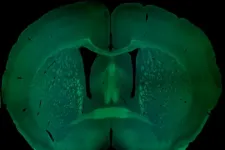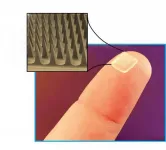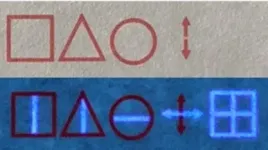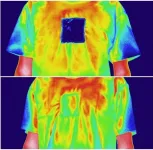Repeat vape aerosol exposure causes minimal damage to lung tissue compared to cigarettes
How does vape aerosol affect lung cells over time? Scientific Digital Communications Editor Arran Frood details the latest research findings at Imperial Brands
2021-05-05
(Press-News.org) 5 May 2021, Bristol - In one of the most advanced applications of in-vitro 3D human lung models in vape research to date, a new peer-reviewed Imperial Brands study shows that, unlike combustible cigarette smoke, blu aerosol had little to no impact on numerous toxicological endpoints under the conditions of test using laboratory models.
Published in the journal Current Research in Toxicology, the experiments compared the toxicological responses of an in vitro 3D lung model (MucilAir™ from Epithelix) after repeated exposure to undiluted whole blu aerosol (1.6% tobacco flavour) or diluted whole cigarette smoke (3R4F Kentucky Reference) over a 28-day period.
After repeatedly exposing the model to smoke or aerosol from each product for four weeks, scientists assessed the biological activity of the 3D lung tissue model against five endpoints related to respiratory function:
Cytotoxic response (general toxicity to cells or tissue)
Barrier integrity (measuring the intactness of tissue structure )
Immunohistochemistry (general assessment of tissue structure)
Cilia beat frequency and active area (detecting abnormal lung cell function)
Pro-inflammatory response (identifying lung tissue inflammation)
This is the first peer-reviewed vaping study evaluating repeated whole cigarette smoke and whole aerosol exposure to a 3D lung model (at the air liquid interface) for this extended 28-day time period.
The use of a 3D lung model and extending the exposure scenario produced a more clinically relevant setup than previous applications, because the model is a closer representation of how the human lung is exposed to aerosol or smoke.
The Toxicity Testing in the Twenty-First Century (TT21C) driven study reinforces Imperial Brands commitment to using advanced 3D tissue models and cellular assays to as part of a global movement to reduce industry reliance on in-vivo (animal) experiments. (Imperial does not test any products on animals, unless formally required to do so by governments or recognised regulatory authorities. See our Position here.)
Results consistent with previous findings
Correlating with Imperial's previous published applications of using a similar method, in the previous study an acute exposure to undiluted whole vape aerosol showed similar biological impact to the lung cell model as humidified air under the experimental conditions. However, diluted combustible cigarettes smoke elicited a significant dose-dependent response in all measured endpoints listed above.
As expected, in the present repeated exposure study, cigarette smoke produced a significant and dose-dependent biological response against all endpoints as the puff number was increased. "Cytotoxicity and inflammatory markers were all elevated in cigarette smoke," said Fan Yu, Pre-Clinical Toxicologist at Imperial Brands and corresponding author. "Likewise, diluted cigarette smoke disrupted normal cilia beat function, cell barrier integrity, as well as tissue structure."
At each puff dose, undiluted blu aerosol contained at least seven times more nicotine relative to cigarette smoke, but for all endpoints elicited no statistically significant difference with the negative control exposed only to humidified air. "Our results suggest nicotine is not the driver of the model's cytotoxic response to cigarette smoke," Yu explained. "More likely it is the many toxicants created through burning tobacco causing the responses that are absent, or substantially reduced, in vape aerosol."
The study is further evidence that vaping may have significant harm reduction potential compared to combustible cigarettes for adult smokers who would otherwise continue to smoke.
"For adult smokers who are uninterested or unwilling to stop smoking, this study adds to a growing body research demonstrating Next Generation Products such as vapes offer a potentially reduced harm alternative if adult smokers choose to transition to these products," said Dr Grant O'Connell, Head of Tobacco Harm Reduction Science.
He added: "To ensure adult smokers are fully informed of the scientific evidence base underpinning NGPs , we urge regulators, policy makers and media alike to recognise and communicate the scientific evidence, such as that presented here, as well as many other findings in the literature, and support a role for high quality, scientifically substantiated products in maximising tobacco harm reduction."
INFORMATION:
See release on IMB Science website: https://imperialbrandsscience.com/timeline/repeated-exposure-to-vape-aerosol-causes-minimal-damage-in-human-lung-tissue-lab-model-compared-to-cigarette-smoke/
Read the full study here: https://www.sciencedirect.com/science/article/pii/S2666027X21000098?via%3Dihub
You are free to share this content with credit to Imperial Brands under a Attribution-NoDerivatives 4.0 International (CC BY-ND 4.0) license: https://creativecommons.org/licenses/by-nd/4.0/
[Attachments] See images for this press release:
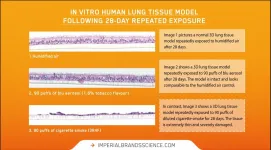
ELSE PRESS RELEASES FROM THIS DATE:
2021-05-05
Announcing a new article publication for BIO Integration journal. In this editorial the authors Hui Liu and Juan Chen from Shanxi Eye Hospital, Taiyuan, China discuss biophotonics in photomedicine.
As a cross-disciplinary field, biophotonics is a natural platform for innovation, e.g. researchers have taken advantages of the recently developed nanostructures in Photomedicine to optimize imaging signals and improve drug delivery efficiency. Active investment in healthcare also contributes to the quick clinical transitions of biophotonic innovations.
However, to genuinely and successfully improve people's lives, many gaps have to be bridged. Horizontally, ...
2021-05-05
After reviewing a database of gene mutations in children with autism spectrum disorder (ASD), a team of Medical University of South Carolina (MUSC) researchers decided to study a specific gene mutation that likely caused ASD in a girl. They demonstrated that the mutation was damaging to the gene, and that female, but not male, mice lacking a working copy of the gene also showed ASD-associated symptoms. Better understanding the interplay between genetics and sex in ASD could set the stage for developing sex-specific treatments for autism.
The MUSC team was led by Christopher Cowan, Ph.D., the William E. Murray SmartState Endowed Chair in Neuroscience and chair of the Department of Neuroscience, and Ahlem Assali, Ph.D., research assistant ...
2021-05-05
A recent study from the University of Helsinki monitors the breakthrough progresses in the development of microneedles for immunotherapy and discusses the challenges regarding their production. Researchers suggest using microneedles for immunotherapy due to the high abundance of immune cells under the skin. The aim is to vaccinate or treat different diseases, such as cancer and autoimmune disorders, with minimal invasiveness and side effects.
"Our study addresses the recent achievements in the development of microneedles for immunotherapy of hard-to-treat and chronic diseases to achieve the highest efficiency with minimal side effects," says ...
2021-05-05
There is currently no consensus on what quality end-of-life care for children with cancer looks like, or how to measure and deliver it; however, investigators recently assembled an expert panel to help fill this void. In a study published early online in CANCER, a peer-reviewed journal of the American Cancer Society, the panel endorsed 16 measures that cover different aspects of care that are important for children with cancer and their families.
"Measuring the quality of the care delivered is an essential part of ensuring high quality end-of-life care ...
2021-05-05
Coded messages in invisible ink sound like something only found in espionage books, but in real life, they can have important security purposes. Yet, they can be cracked if their encryption is predictable. Now, researchers reporting in ACS Applied Materials & Interfaces have printed complexly encoded data with normal ink and a carbon nanoparticle-based invisible ink, requiring both UV light and a computer that has been taught the code to reveal the correct messages.
Even as electronic records advance, paper is still a common way to preserve data. Invisible ink can hide classified economic, commercial or military ...
2021-05-05
Marine scientists are calling on the EU to adopt a comprehensive plan to protect dolphins and porpoises from fisheries bycatch in European waters.
A team of conservation experts, including Newcastle University's Professor Per Berggren, highlight limitations in EU's efforts to address and mitigate bycatch. The scientists argue this infective response is a result of scattered and complicated management responsibility for the conservation of dolphins and porpoises in Europe, and from a lack of quantitative conservation objectives, including biological reference points ...
2021-05-05
Reflexes protect our bodies - for example when we pull our hand back from a hot stove. These protective mechanisms could also be useful for robots. In this interview, Prof. Sami Haddadin and Johannes Kühn of the Munich School of Robotics and Machine Intelligence (MSRM) of the Technical University of Munich (TUM) explain why giving test subjects a "slap on the hand" could lay the foundations for the robots of the future.
In your paper, published in Scientific Reports, you describe an experimental setup where people were actually slapped on the hand - to study their reflexes....
Kühn: Yes, you can put it that way. For our study, in cooperation with Imperial College London, the test ...
2021-05-05
Clothing, from tank tops to parkas, helps people adapt to temperatures outdoors. But you can only put on or take off so much of it, and fluctuations in weather can render what you are wearing entirely inadequate. In a new study in ACS' Nano Letters, researchers describe a high-tech alternative: a reversible textile they designed to trap warmth in the cold and reflect it during hot weather, all while generating small amounts of electricity.
Previous attempts to develop such sophisticated textiles for outdoor use have generally focused on either capturing thermal radiation or dispersing it. To integrate the two, Qiang Li, Min Qiu and colleagues made a ...
2021-05-05
More research is urgently needed into the impact that attending suicide events is having on paramedics and other first responders, a researcher at the University of Otago, New Zealand, says.
PhD student Renan Lyra, a psychologist by training, says a significant proportion of police officers, firefighters and paramedics will attend at least one suicide event in their careers, but there has been little research into the impact this has on their personal and professional lives and on their own suicide risk.
Mr Lyra has reviewed 25 research papers on the impact attending a suicide event has on those ...
2021-05-05
A curiously yellow star has caused astrophysicists to reevaluate what's possible within our universe.
Led by Northwestern University, the international team used NASA's Hubble Space Telescope to examine the massive star two-and-a-half years before it exploded into a supernova. At the end of their lives, cool, yellow stars are typically shrouded in hydrogen, which conceals the star's hot, blue interior. But this yellow star, located 35 million lightyears from Earth in the Virgo galaxy cluster, was mysteriously lacking this crucial hydrogen layer at the time of its explosion.
"We haven't seen this scenario before," said Northwestern's ...
LAST 30 PRESS RELEASES:
[Press-News.org] Repeat vape aerosol exposure causes minimal damage to lung tissue compared to cigarettes
How does vape aerosol affect lung cells over time? Scientific Digital Communications Editor Arran Frood details the latest research findings at Imperial Brands

